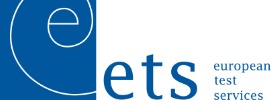News
European Test Services (ETS) B.V.
Ariane 6 Upper stage in the LEAF
Ariane 6 Upper Stage successfully completes Acoustic Test
08 November 2024
We are pleased to announce that the Ariane 6 upper stage has passed its acoustic reverberation test in ESA’s Large European Acoustic Facility (LEAF), operated by European Test Services (ETS) B.V and specified by ArianeGroup. This milestone supports the further development of Ariane 6 following its inaugural flight.
The test simulated the intense sound environment during liftoff. This ensures the structural integrity and performance of the upper stage. The Ariane 6 upper stage, developed by ArianeGroup and the largest object tested in LEAF to date, withstood the high-decibel noise levels with resilience.
LEAF, known for its acoustic testing capabilities, subjected the upper stage to sound waves replicating launch conditions. This verifies not only the upper stage during these conditions but also supports the structural model verification.
The successful test marks a key achievement in the Ariane 6 vehicle’s development, highlighting the upper stage’s robustness and reliability. This stage is designed to enhance Europe’s space access by offering greater launch flexibility and efficiency.
ETS wants to congratulate the ArianeGroup team for this accomplishment. The successful test reflects their dedication and expertise. It is also a significant achievement for LEAF, showcasing its ability to handle complex testing projects.
The Ariane 6 program, developed by ArianeGroup and partners on behalf of the European Space Agency (ESA), represents a new era in European space capabilities. With better performance and cost-efficiency, Ariane 6 will meet global space industry demands.
We at ETS are proud to support the Ariane 6 team and wish them success in their missions and future operations.

Hera on QUAD Shaker
Hera satellite successfully passes environmental tests!
28 August 2024
We are proud to announce that ESA’s Hera satellite has successfully completed its comprehensive environmental testing campaign at the ESA Test Centre, operated and maintained by European Test Services (ETS) B.V. with OHB System AG as prime contractor of the Hera satellite. Hera is now one step closer to its goal of studying the Didymos asteroid.
Environmental testing was crucial to ensure the satellite’s functionality under harsh conditions it will face during launch and in space. Hera underwent a series of rigorous tests, including vibration testing, acoustic noise testing, thermal vacuum testing, and electromagnetic compatibility (EMC) testing.
With all tests successfully completed, Hera will soon leave the ESA Test Centre. We at ETS extend our congratulations to the entire Hera team for reaching this milestone. We are proud to have contributed to this mission and wish the Hera team every success in the upcoming launch and mission operations. Hera’s mission will provide vital data for future planetary defense efforts, helping to protect Earth from potential asteroid threats.
Photo: Hera on QUAD Shaker, ©ESA Credit: ESA-SJM Photography
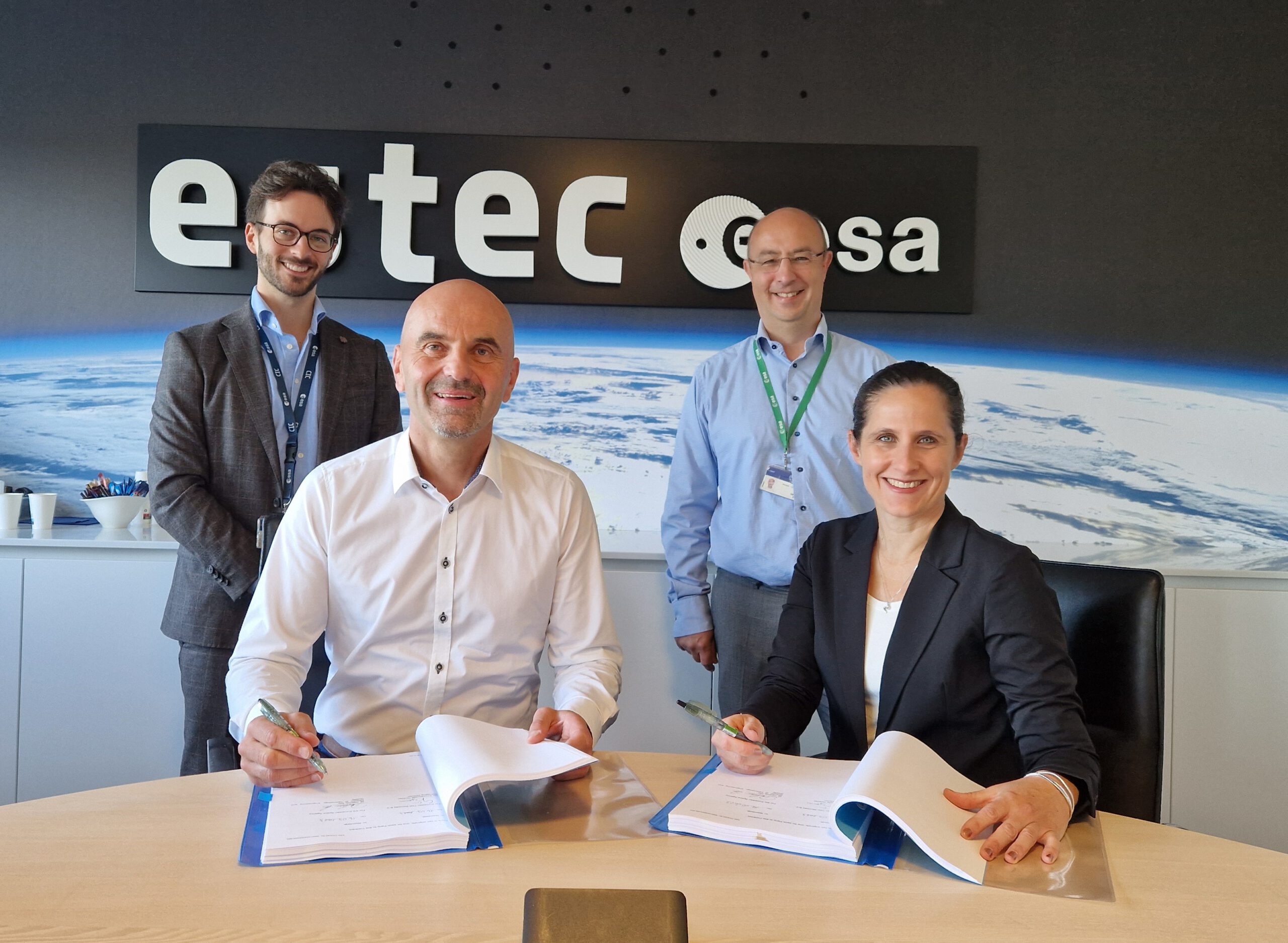
Contract signature between ESA and ETS
ETS and ESA continue their Journey Together!
10 October 2023
ETS is thrilled to announce the signing of a contract that marks an extraordinary partnership, which will set the stage for innovation, excellence, and collaboration like never before! This agreement on the Management, Maintenance, Operations, Marketing & Sales of the ESA Test Centre covers the years 2024 to 2028. The significance of this collaboration cannot be overstated, it signifies a harmonious convergence between ETS and ESA that exists since the year 2000.
ESA’s Director of Technology, Engineering & Quality, Mr. Dietmar Pilz, and ETS’ Managing Director, Ms. Emmanuelle Goavec, signed last month this contract that will further shape the future of ESA test centre. This remarkable event took place in the presence of distinguished guests, Mr. Gaetan Piret head of the ESA test centre and Mr. Maximilian Garre, contracts officer.
We extend our deepest gratitude to ESA for placing their trust and confidence in ETS. This partnership reaffirms our dedication to excellence and our passion for pushing the boundaries in testing. The trust placed in us is not taken lightly, and we are fully aware of the responsibility it carries.
The ETS team is proud to embrace this incredible opportunity and is eagerly looking forward to continuing the remarkable journey ahead. Together, we shall continue to nurture the spirit of collaboration, innovation, and excellence that defines our collective endeavours.
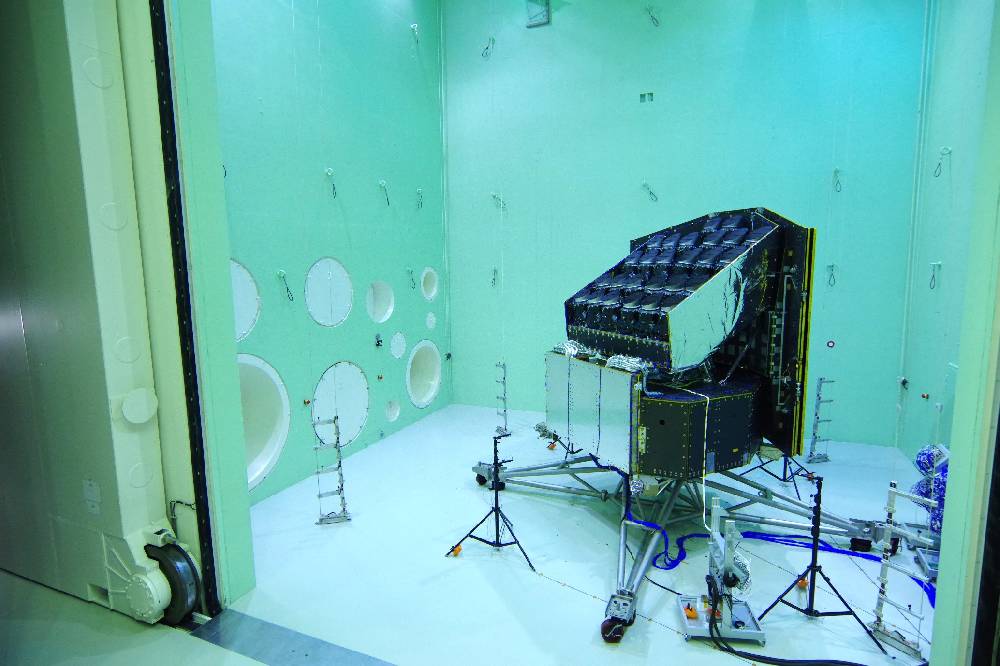
PLATO SM in the Large European Acoustic Facility (LEAF)
PLATO SM testing on track!
28 June 2023
PLATO (PLAnetary Transits and Oscillations of stars) is a medium-class mission in ESA’s Cosmic Vision programme with the objective to find and study planets beyond our own Solar System. The development of PLATO is performed under lead responsibility of OHB system. The ESA facilities are operated by ETS.
The structural model (SM) of the PLATO spacecraft, consisting of the payload module, the service module and a sunshield Solar array, has completed the major parts of the test campaign in ESA’s Test Centre in June 2023.
The test campaign consists of the determination of mass properties (mass, center of gravity in three axes), vibration up to qualification level in three axes, acoustic noise up to qualification level, and clamp band release (shock) test. The image shows the PLATO spacecraft test setup in ESA’s Large European Acoustic Facility (LEAF) in Noordwijk, NL.
Subsequent deployment tests of the sunshield-solar array in Noordwijk and a micro-vibration test to be performed by IABG at OHB Bremen will complete the test campaign.
Note: The view expressed herein can in no way be taken to reflect the official opinion of the European Space Agency.
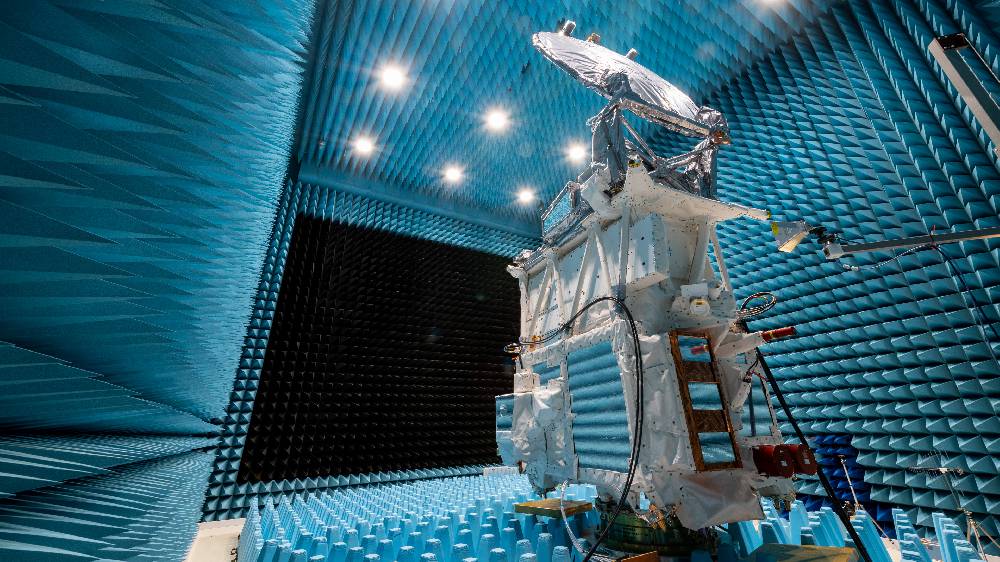
EarthCARE Successfully finishes EVT Campaign
12 April 2023
EarthCARE (Cloud, Aerosol and Radiation Explorer) successfully finished its environmental test campaign after performing their last test in ESAs EMC chamber called Maxwell. In this chamber radiated emission and susceptibility tests have been conducted to ensure the system’s nominal performance and to verify compatibility with the launcher. The chamber also allowed the customer to safely operate the spacecraft in the electromagnetic environment that it will experience in flight configuration (free space).
The European prime contractor of EarthCARE is Airbus Defence and Space GmbH. This ESA mission is one of the most complex of all Earth Explorers and will help us understanding the role of clouds and aerosols in reflecting incident solar radiation back into space and trapping infrared radiation emitted from Earth’s surface. EarthCARE is a joint mission between ESA and JAXA (Japan Aerospace Exploration Agency). The test facility operations for the environmental test campaign were performed by ETS.
Note: The view expressed herein can in no way be taken to reflect the official opinion of the European Space Agency.
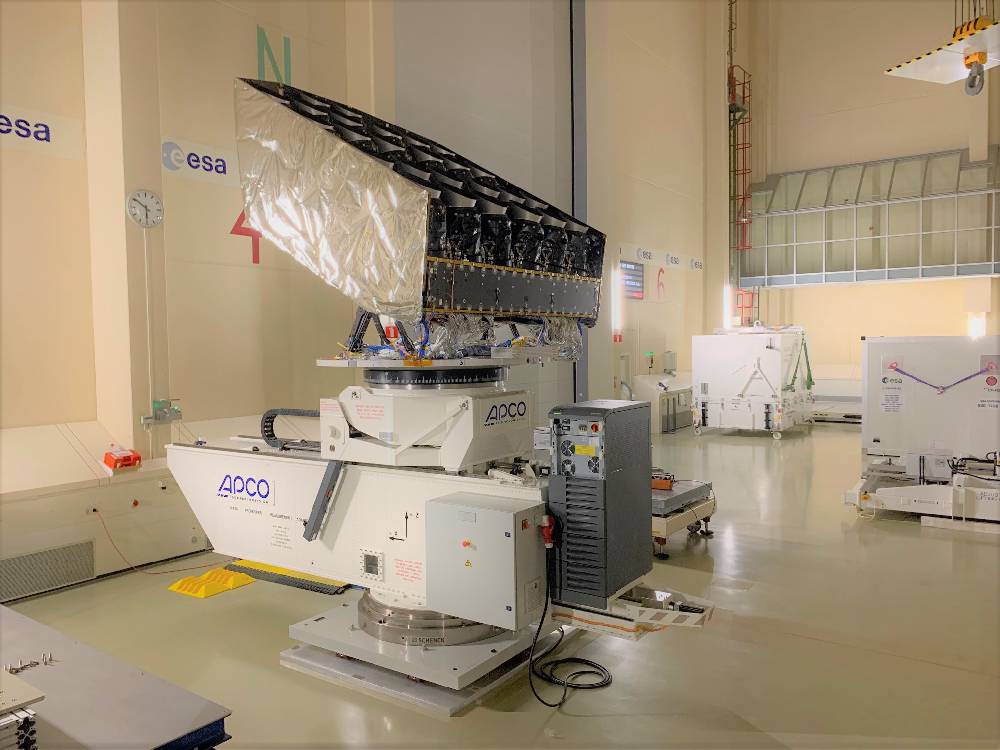
PLATO PLM STM on the M80/MPMA Facility
PLATO PLM Successfully finishes EVT Campaign
25 May 2022
The PLAnetary Transits and Oscillations of stars (PLATO) structural and thermal model of the Payload Module (PLM) successfully finished its mechanical and thermal qualification test campaign. After determining the centre of gravity, performing vibration tests including quasi static vibration above 10 g and finishing with thermal balance and vacuum cycling test the PLM structure and thermal control now have been qualified.
The ESA PLATO project has been contracted to a core industrial team consisting of OHB, Thales Alenia Space and Beyond Gravity. The test facility operations for the PLM campaign were performed by ETS.
Note: The view expressed herein can in no way be taken to reflect the official opinion of the European Space Agency.
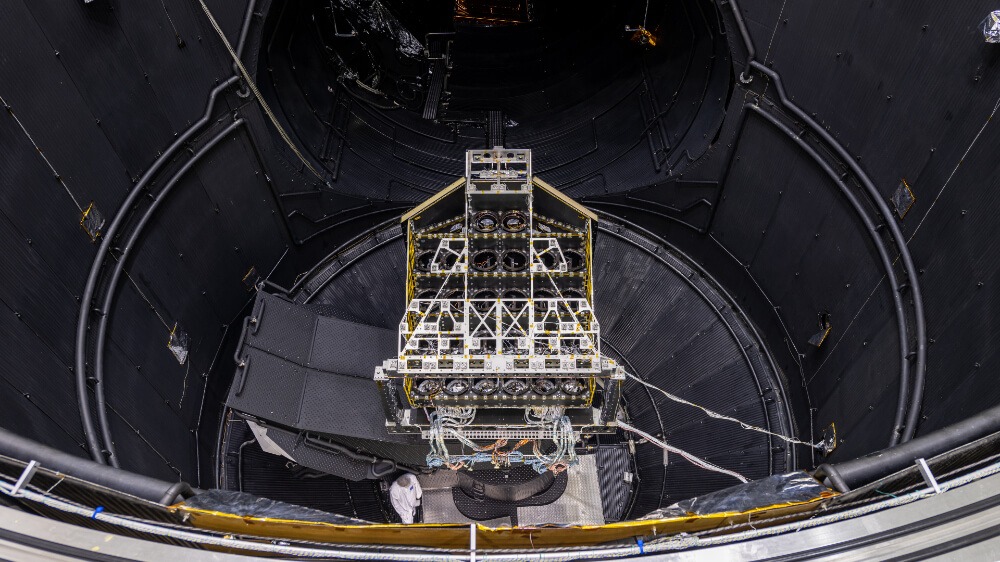
PLATO PLM Successfully finishes TED Test
20 September 2021
The PLAnetary Transits and Oscillations of stars (PLATO) structural and thermal model of the Payload Module (PLM) successfully finished its thermo elastic deformation (TED) test in ESA’s Large Space Simulator (LSS). Inside the LSS, operated by ETS, several thermal deformation scenarios were applied on the optical bench assembly structure, which will later on carry the instrument consisting of 26 cameras, while the TED GSE surrounding was provided and used by OHB to perform laser interferometry measurements.
Facility related key factor to the test success was the stability of the LSS shrouds and the automated thermal control cycling with test heaters.
The PLATO PLM equipped with the 26 cameras as mass and thermal dummies will be back at ETS/ESTEC beginning 2022 for performing its mechanical and thermal environmental test campaign in order to qualify the PLM structure.
Note: The view expressed herein can in no way be taken to reflect the official opinion of the European Space Agency.

JUICE PFM Successful Space Simulation Test
16 July 2021
The JUpiter ICy moons Explorer (JUICE) Proto-Flight Model successfully finished its 4 weeks Thermal Balance/Vacuum test in ESA’s Large Space Simulator (LSS). Inside the LSS, operated by ETS, several mission scenarios were tested including sun simulation to simulate the Venus fly by that will be encountered during the long journey to Jupiter. The test data are currently under analysis by Airbus Defence and Space, prime contractor of the JUICE spacecraft.
This is the icing on the cake for the teams of Airbus Defence and Space, ETS and ESA after working several years together to address the technical and logistical challenges of this test campaign. The LSS has been equipped in the meantime with the means to fulfil the specific test requirements of JUICE. This included for instance, the development of a dedicated setup to route waveguides from the spacecraft outside the chamber while still making it compatible with the movement of the facility’s Motion System.
ETS ends this campaign, after hosting a transnational team of more than 100 persons during 3 months, by supporting Airbus Defence and Space to ship JUICE PFM by air freight to their facilities in Toulouse. In Toulouse the final validation takes place before launch in 2022 (with arrival at Jupiter in 2031).
Note: The view expressed herein can in no way be taken to reflect the official opinion of the European Space Agency.

PLATO Camera STM inside VTC1.5 Thermal Vacuum Facility
PLATO Camera STM successfully finishes
Thermal Balance Test
09 February 2021
The PLATO Camera Structural Thermal Model (STM) has successfully finished its TB TV test in the VTC 1.5 facility. The objective of the test was to validate the thermal design, interfacing with other units and mapping thermal gradients. The PLATO payload will consist of 24 cameras.
Parties involved in the test were ESA, OHB (prime contractor of the PLATO satellite), SRON (camera AIT), University of Bern (camera mechanical structure) and ETS (facility operation). The VTC 1.5 facility was run in semi-autonomous mode.
ESA’s PLATO (PLAnetary Transits and Oscillations of stars) mission has the objective to find and study extrasolar planetary systems, especially habitable planets around solar-like stars. PLATO will also investigate seismic activity in stars to characterise their age.
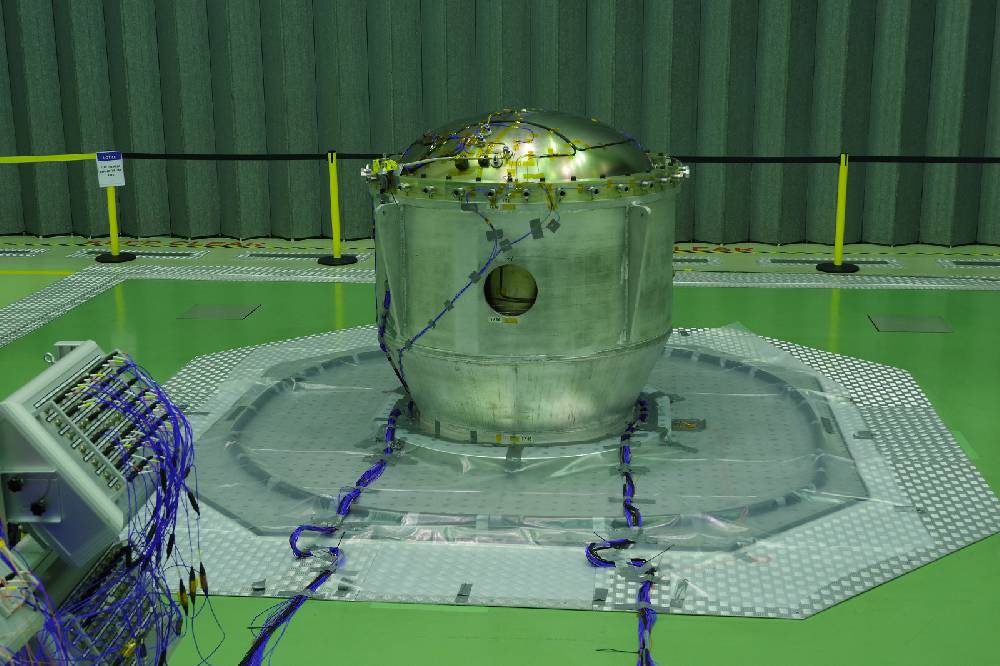
Eurostar NEO / JUICE Propellant Tank on the 640kN QUAD Shaker
Eurostar NEO / JUICE Propellant tank qualification vibration test
05 October 2020
The 1630 litres Eurostar NEO propellant tank qualification model is now undergoing extensive vibration testing at ETS/ESTEC. Two of these tanks made out of Titanium alloy will be used on board the JUICE satellite as around 3000kg of propellant is needed to arrive at Jupiter and to perform its flybys around Jupiter’s moons.
The propellant tank is designed and developed by Airbus Defence and Space UK and tested by European Test Services (ETS) B.V., operator of the ESA test centre.
Eurostar NEO is part of the Neosat Partnership Projects aimed at developing and qualifying the next generation platforms allowing the two European satellite prime integrators, Airbus DS and Thales Alenia Space to deliver competitive satellites for the commercial satellite market. Neosat is part of ESA’s Advanced Research in Telecommunications Systems (ARTES) programme and is based on a cooperation between ESA and CNES.
JUICE – JUpiter ICy moons Explorer – is the first large-class mission in ESA’s Cosmic Vision 2015-2025 programme. It will complete a unique tour of the Jupiter system that will include in-depth studies of three potentially ocean-bearing satellites, Ganymede, Europa and Callisto.
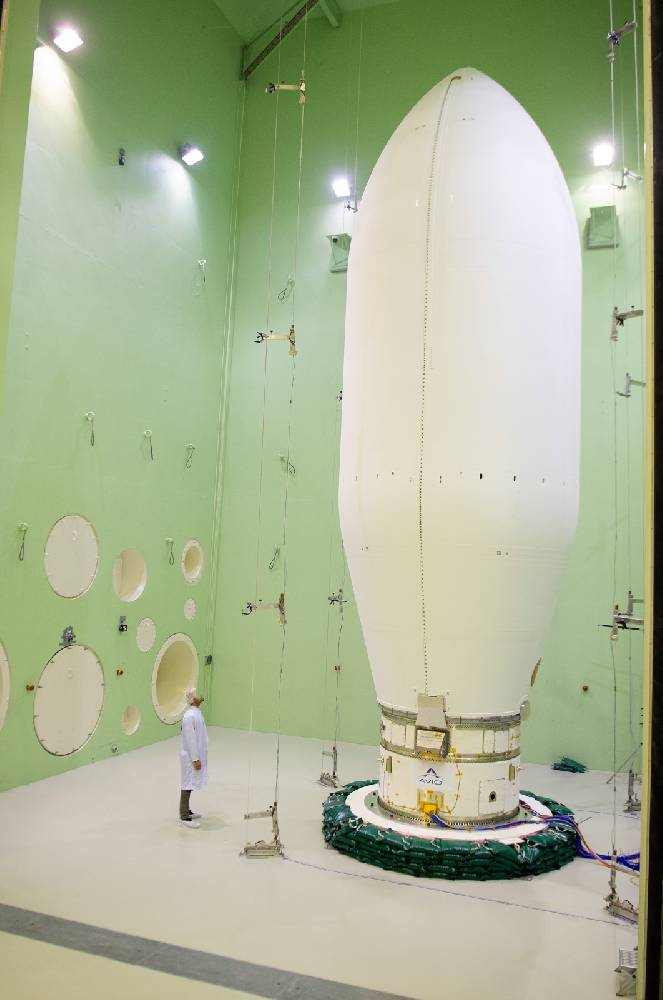
Photo credit ESA G. Porter
VEGA C AVUM+ Test campaign
04 December 2019
The VEGA C 4th stage and fairing acoustic test campaign has successfully finished. ETS’ customer AVIO, VEGA prime contractor, has performed rigorous acoustic testing of the AVUM+ and fairing inside ESA’s Large European Acoustic Facility (LEAF). To characterise the fairing’s attenuation 48 microphones were positioned to measure the acoustic noise inside the fairing. The fairing is developed by RUAG Space and the acoustic facility was operated by ETS.

MetOp-SG STM Satellite Successful Test Campaign Completion
24 September 2019
The MetOp-SG programme is a cooperative undertaking between ESA (the European Space Agency) and EUMETSAT (the European Organisation for the Exploitation of Meteorological Satellites).
The MetOp-SG Structural and Thermal Model (STM) satellite underwent its final environmental test in ESA’s Large Space Simulator. Several orbit scenarios, including sun simulation, have been tested few days ago. The Thermal test data are currently under analysis by Airbus Defence and Space, the customer of European Test Services.
The teams of Airbus Defence and Space, ETS and ESA started the test campaign preparation in 2018. Mechanical qualification tests and Thermal Vacuum tests were performed in the ESA test facilities, operated by ETS, between June and September, this year. Airbus Defence and Space is now focusing on the start of the MetOp-SG Satellite A PFM to be launched at the end of 2022.
Note: The view expressed herein can in no way be taken to reflect the official opinion of the European Space Agency.
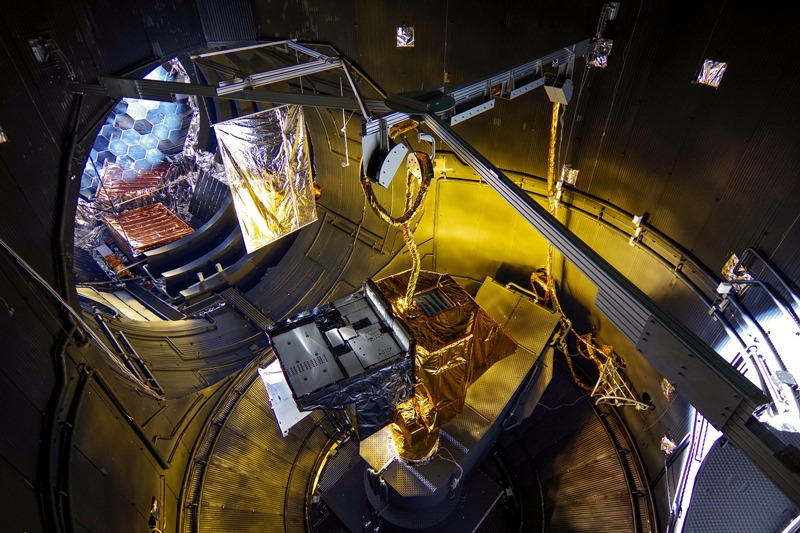
Infrared Sounder STM successfully tested
19 August 2019
Meteosat Third Generation´s (MTG) Infrared Sounder (IRS) is one of the two GEO-stationary satellite on-board instruments. The IRS instrument will support Numerical Weather Prediction at regional and global scales, through the provision of Atmospheric Motion Vectors (AMV) with high vertical resolution.
The purpose of the STM thermal balance and vacuum test was to validate the thermal control system of the instrument and the cryocooler (active cryostat at around 55K and common to the Imager S/C and the Sounder S/C). During the test the IRS turned in and out an artificial 6m sunbeam including eclipses to simulate the solar entrance into the instrument cavity (baffle).
For testing purposes, the IRS STM was mounted to a satellite sidewall simulator and connected to an electric power harness to simulate the power dissipation of on board equipment. The external harness was routed to a special supporting structure that accommodated multiple rotations between 3-357 degrees, allowing spinning of the instrument, eclipse and illumination by a 6m sunbeam of 1340W/m2.
ETS operated ESA´s Large Space Simulator in vacuum and thermal condition close to the space environment, with OHB System AG in charge to conduct the test for various functional states of the instrument: e.g. survival, operational and transition modes, steady state and sensitivity of the cryostat.
The test was successfully completed with all the results fulfilling the objectives and ahead of the planned schedule thanks to the collaboration of all the team involved, ESA, OHB, TAS-F and ETS.
MTG is a satellite series of four imaging and two sounding satellites for weather predictions. Thales Alenia Space France as MTG prime contractor and OHB System AG, as MTG-S Mission Prime and provider of the MTG Satellite-Platforms, develop the satellites under responsibility of ESA and on behalf of The European Organization for the Exploitation of Meteorological Satellites (EUMETSAT). EUMETSAT will operate the satellites carrying in total four instruments for weather forecast and climate prediction.

MetOp-SG STM heading towards final tests
23 July 2019
The MetOp-SG Structural and Thermal Model (STM) is now heading for its acoustic test after successfully passing the dry and wet vibration tests including sine burst testing up to 6.5 g on the 640kN QUAD shaker.
In the coming weeks ETS customer Airbus Defence & Space will be analysing the huge data sets acquired during the vibration test and upcoming acoustic noise test and shock test. The final destination after the mechanical tests is ESA’s Large Space Simulator.
The MetOp-SG programme is a cooperative undertaking between ESA (the European Space Agency) and EUMETSAT (the European Organisation for the Exploitation of Meteorological Satellites). The ESA test facilities are operated by ETS.
Note: The view expressed herein can in no way be taken to reflect the official opinion of the European Space Agency.
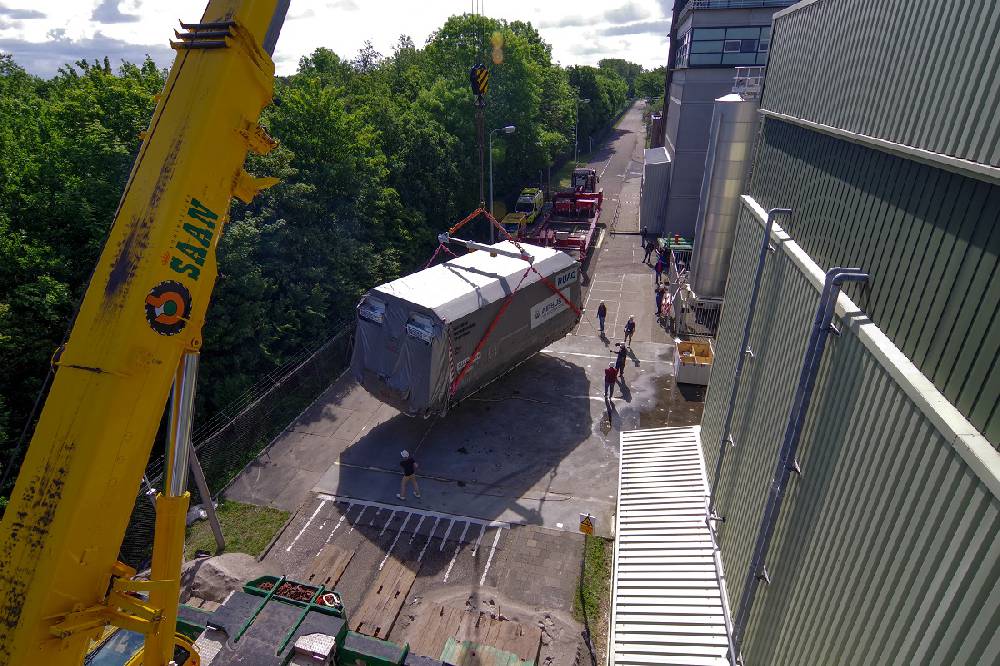
Container offloaded by crane
MetOp-SG STM arrival at ETS/ESTEC
26 June 2019
The MetOp Second Generation (MetOp-SG) structural and thermal model has arrived at ETS/ESTEC for its environmental test campaign. As contractor for the Management, Maintenance, Marketing and Sales of the ESTEC Test Facilities, ETS will perform vibration, acoustic noise and space simulation tests.
ETS’ direct customer is Airbus Defence & Space SAS. The MetOp-SG programme is a cooperative undertaking between ESA (the European Space Agency) and EUMETSAT (the European Organisation for the Exploitation of Meteorological Satellites). Their objective for MetOp-SG is to provide operational observations and measurements from polar orbit for numerical weather prediction and climate monitoring in the early 2020’s to mid-2040’s timeframe. In addition, MetOp-SG will provide services to atmospheric chemistry, operational oceanography and hydrology.
Note: “The view expressed herein can in no way be taken to reflect the official opinion of the European Space Agency.”
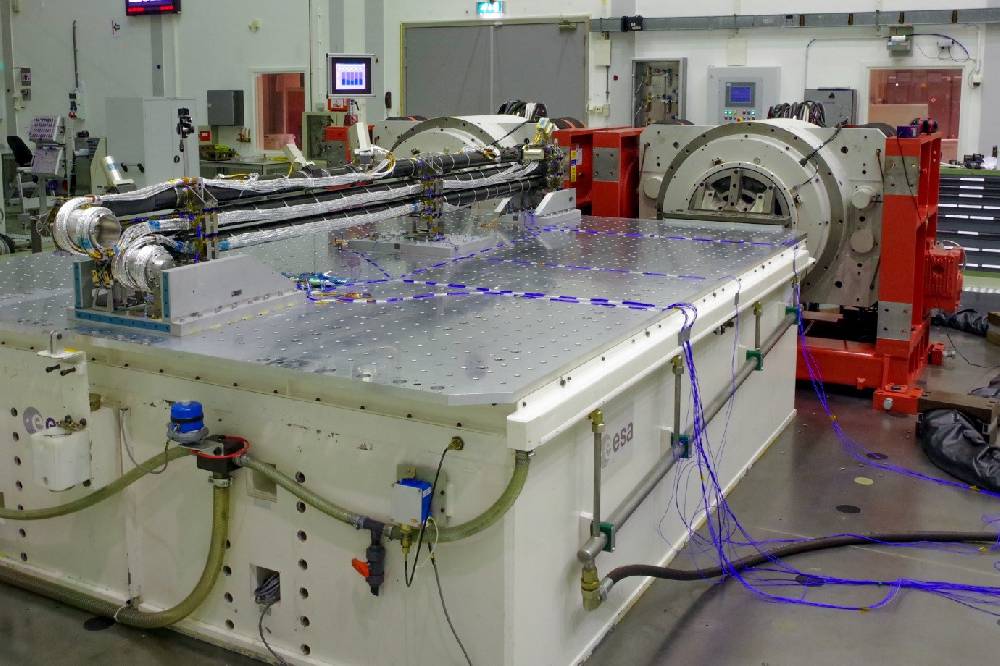
Vibration Test JUICE MAGBOOM EQM on the 320kN Multishaker
JUICE MAGBOOM EQM Vibration test
26 March 2019
The JUICE EQM Magboom has been rigorously tested up to levels of 17 g on the QUAD and Multishaker and was successfully deployed after the vibration test.
The JUICE Magboom will be part of ESA’s Jupiter Icy Moon Explorer satellite. The boom will deploy magnetic experiments and sensors when the satellite is around Jupiter. As very low magnetic field changes are to be measured the boom will have a deployed length of 10.6m in order to minimize the magnetic disturbances from the satellite.
The Magboom is designed and developed by SENER and tested by European Test Services (ETS) B.V., operator of the ESA test centre.
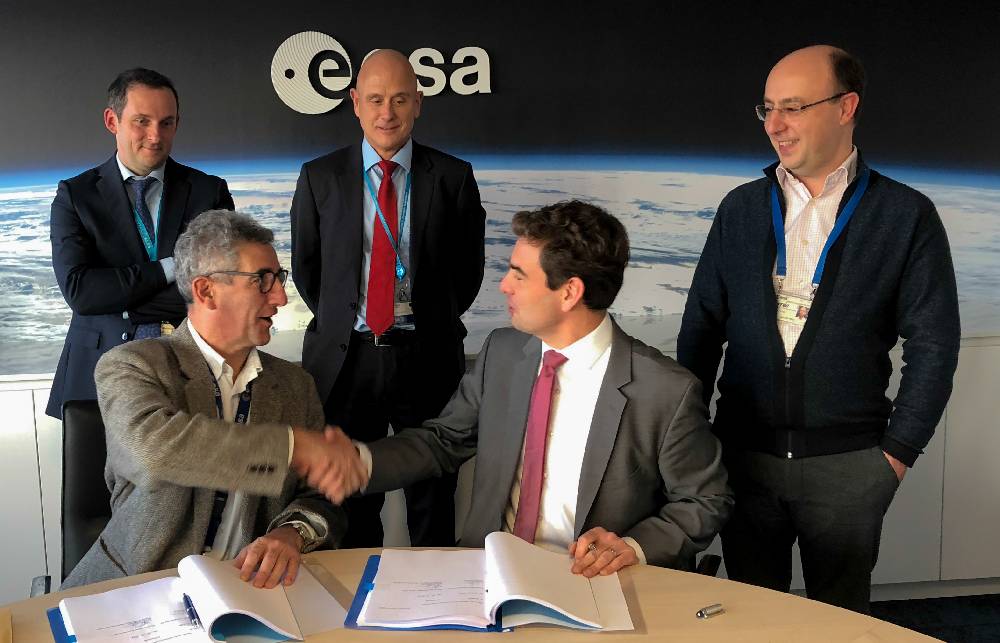
ESA and ETS representatives after contract signature (image credit ESA-K. Hristova)
ETS ensures its future beyond 2020
14 December 2018
ETS is proud to announce that the contract regarding the Management, Maintenance, Operations, Marketing & Sales of the ESTEC Test Centre Facilities for the period from 2019 to 2023 has been signed today. ESA’s Director of Technology, Engineering & Quality, Mr Franco Ongaro, signed the contract with the ETS’ Managing Director, Dr Jörg Selle, in the presence of Mr Torben Henriksen, Mr Gaetan Piret and Mr Benjamin Jeusset. ETS would like to thank ESA for placing their trust and confidence in its abilities to operate the ESA test centre. The ETS team is looking forward to continuing the great cooperation.
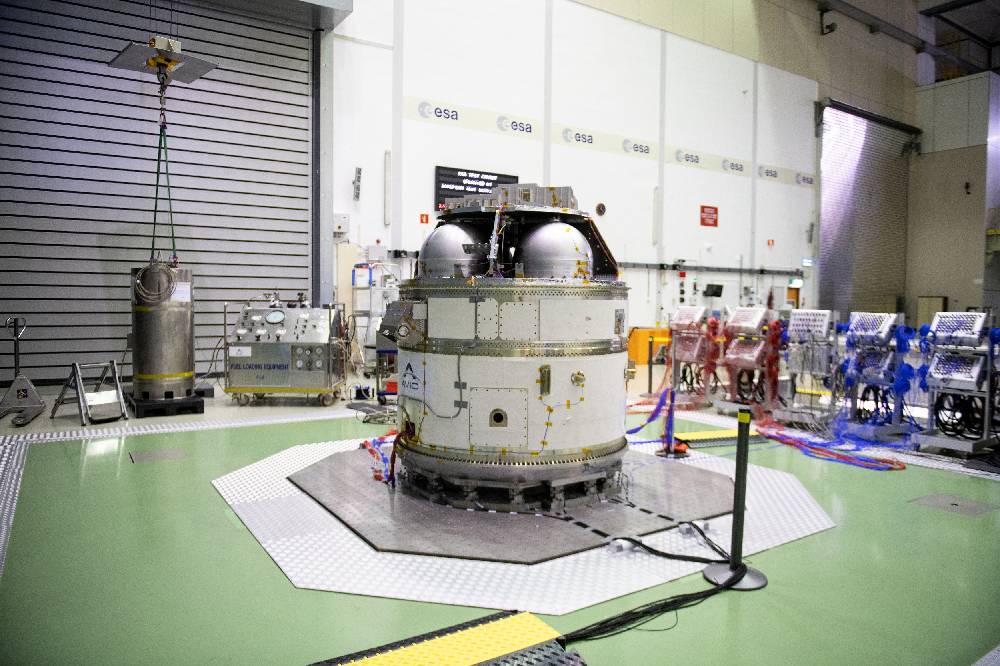
Vibration Test VEGA AVUM+ on the 640kN QUAD Shaker (image credit: ESA-G. Porter)
VEGA C AVUM+ Test campaign
23 November 2018
The VEGA C 4th stage (or Attitude Vernier Upper Module, AVUM+) vibration test campaign has successfully finished. ETS’ customer AVIO, VEGA prime contractor, has performed rigorous vibration testing of the AVUM+ on the QUAD and Multishaker. During more than 30 vibration test runs ETS acquired 450 data channels of acceleration and forces.
VEGA C is the latest evolution of the VEGA launch system with its main objective to increase performance and reduce operating cost. ESA is overseeing procurement and the architecture of the overall launch system, while industry is building the VEGA launcher.

MTG FCI STM inside the Large Space Simulator (image credit: ESA-G. Porter)
Flexible Combined Imager STM successfully tested
16 July 2018
Meteosat Third Generation’s (MTG) Flexible Combined Imager (FCI) is one of the two GEO-stationary satellite on-board instruments and successor of the current Meteosat’s Seviri instrument. The FCI provides solar and thermal spectral measurements in 16 channels for weather forecast.
The purpose of the STM thermal balance and vacuum test on the FCI was to validate the thermal control system of the instrument and the cryocooler (active cryostat at around 55K and common to the Imager S/C and the Sounder S/C). During the test the FCI turned in and out an artificial 6m sunbeam including eclipses to simulate the solar entrance into the instrument cavity (baffle).
For testing purposes, the FCI STM was mounted to a satellite sidewall simulator and connected to an electric power harness to simulate the power dissipation of on board equipment. The external harness was routed to a special supporting structure that accommodated multiple rotations between 0-360 degrees, allowing spinning of the instrument, eclipse and illumination by a 6m sunbeam of 1340W/m2.
ETS operated the Large Space Simulator in vacuum and thermal condition close to the space environment, with Thales Alenia Space France and OHB System AG in charge to conduct the test for various functional states of the instrument: e.g. survival, operational and transition modes, steady state and sensitivity of the cryostat.
MTG is a satellite series of four imaging and two sounding satellites for weather predictions. Thales Alenia Space France as MTG prime contractor and OHB System AG develop the satellites under responsibility of ESA on behalf of The European Organization for the Exploitation of Meteorological Satellites (EUMETSAT). EUMETSAT will operate the satellites carrying in total four instruments for weather forecast and climate prediction.

DELFT HYPERLOOP on track at VTC 1.5 vacuum facility
23 May 2018
Delft Hyperloop, the overall winner of the 1st Hyperloop pod competition is on track for the 2018 competition that takes place this year on July 22nd. The team from Delft just finished a week of rigorous testing in vacuum environment using ESA’s VTC 1.5 vacuum facility that has a similar diameter as SpaceX’s test tube. The tests and their preparation have been supported by ESA and ETS.
A Hyperloop is a form of transportation by trains or pods travelling under vacuum to lower resistance and increase speed. SpaceX’s Hyperloop competition was created to increase development and innovation.

JUICE Thermal Mock up inside the LSS (copyright ESA)
JUICE TDM successfully performed thermal balance test in the Large Space Simulator
14 May 2018
The purpose of the JUICE thermal balance test was to validate the passive thermal control design of JUICE spacecraft in an early phase. During this test the a full scale Thermal Development Model (TDM) mock-up of the spacecraft was first exposed to a solar flux at 1.8 solar constant to simulate the Venus fly by, followed by a cold case without sun simulation and an additional balance phase at an intermediate solar flux intensity. The Large Space Simulator has been operated by ETS and the test was conducted by Airbus Defence and Space.
JUICE (JUpiter ICy moons Explorer) is a large class ESA mission planned for launch in 2022 and arrival at Jupiter in 2029 where the spacecraft will observe and study the moons Ganymede, Callisto and Europa.
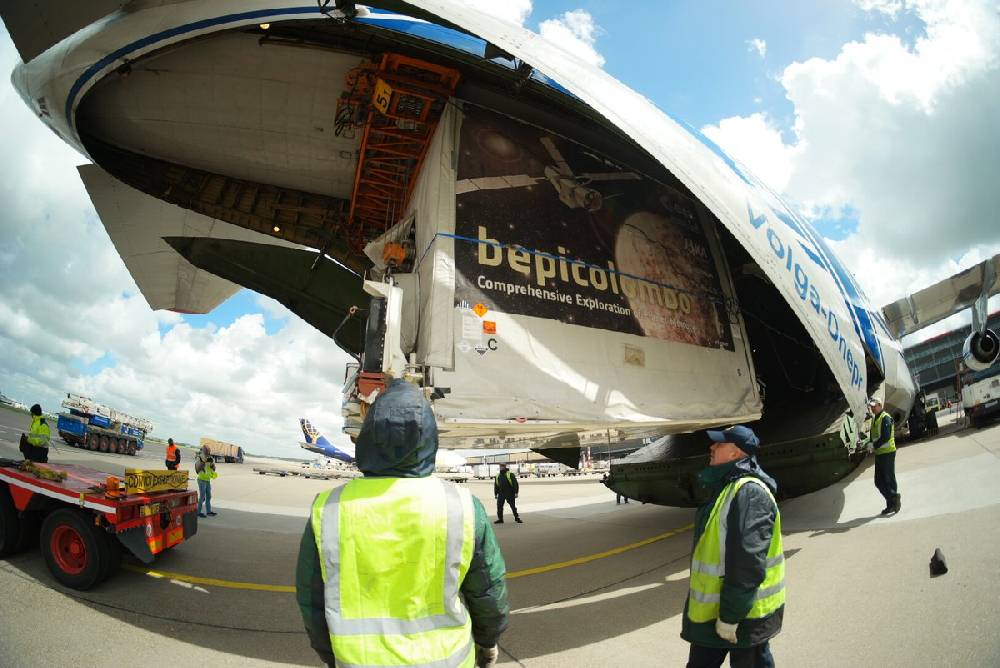
Photo: Credit ESA-M.Cowan
Departure for Mercury
04 May 2018
After their arrival in 2014 and numerous environmental tests until end of 2017, the last items of the BepiColombo project will leave European Test Services (ETS) B.V. on May 7th. The Mercury Planetary Orbiter, Transfer module, Magnetic Orbiter and Sunshield have already been shipped to Kourou in French Guiana. The launch is scheduled for October 2018.
Four Antonovs 124 and one ship are needed to transport the satellites and their related support equipment to the launch site in Kourou French Guiana. Transport preparation, packing and air freight security screening have been already supported by ETS since end of 2017.
BepiColombo is a joint mission between the European Space Agency (ESA) and the Japan Aerospace Exploration Agency (JAXA), executed under ESA leadership. The stacked spacecraft will arrive late 2025 at Mercury where the two orbiters are separated from the transfer module and sun shield. The orbiters will study Mercury’s atmosphere, gravity field, magnetosphere, surface and interior structure.

ETS awarded with contract for the MetOp-SG STM test campaign
29 January 2018
European Test Services (ETS) B.V. has been awarded with the environmental test contract for the MetOp Second Generation (MetOp-SG) prototype satellite.
Airbus Defence & Space SAS has contracted ETS to perform environmental tests on the MetOp-SG structural and thermal prototype satellite. The MetOp-SG satellites will orbit the Earth in pairs: one satellite series is equipped with optical instruments and atmospheric sounders, while the other satellite series is equipped with microwave instruments. Both series are based on Airbus’ Astrobus high-power satellite platforms, the prototype satellite will be a combination of the two different satellites to optimize the development time.
The MetOp-SG programme is a cooperative undertaking between ESA (the European Space Agency) and EUMETSAT (the European Organisation for the Exploitation of Meteorological Satellites). Their objective for MetOp-SG is to provide operational observations and measurements from polar orbit for numerical weather prediction and climate monitoring in the early 2020’s to mid-2040’s timeframe. In addition, MetOp-SG will provide services to atmospheric chemistry, operational oceanography and hydrology.
As contractor for the Management, Maintenance, Marketing and Sales of the ESTEC Test Facilities, ETS will perform vibration, acoustic noise and space simulation tests in the frame of the MetOp-SG environmental test campaign. The tests will commence at the end of this year. Major challenges are the vibration and space simulation tests. For the vibration test on the QUAD shaker, 8 g quasi static acceleration is to be achieved on a total mass of 5 tons. In the Large Space Simulator a new motion system will be used for the first time, this system is able to simulate satellite movement and rotation as in orbit.
“The view expressed herein can in no way be taken to reflect the official opinion of the European Space Agency.”
